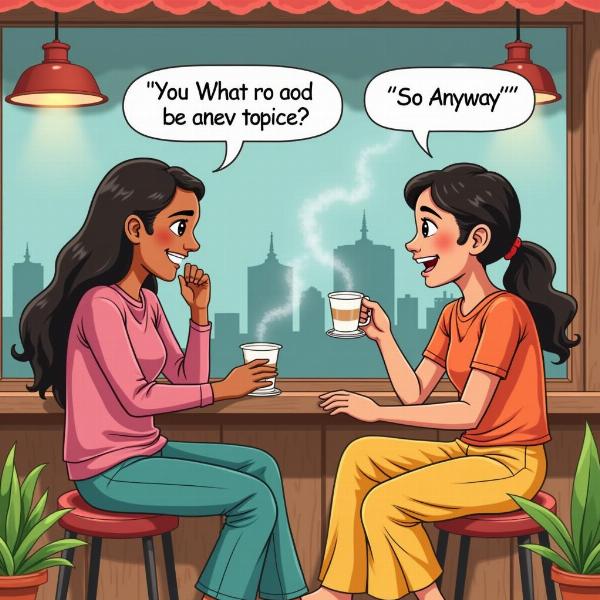“So anyway” is a common phrase in English conversations, used as a discourse marker to transition between topics, resume a previous topic, or summarize a point. Understanding its meaning in Hindi can be tricky, as there isn’t one perfect equivalent. This article will explore various ways to express “so anyway” in Hindi, considering context and cultural nuances. We’ll delve into the subtle meanings behind this seemingly simple phrase and how to best convey its essence in Hindi, whether you are translating a casual conversation, a formal document, or anything in between.
Translating “So Anyway” in Different Contexts
The best Hindi translation for “so anyway” depends heavily on the specific context. Let’s look at a few common scenarios:
-
Resuming a previous topic: After an interruption or digression, “so anyway” brings the conversation back on track. In Hindi, you might use phrases like “खैर, जहाँ तक बात चल रही थी” (Khair, jahan tak baat chal rahi thi) meaning “Well, where we left off…” or “तो बात यह है कि” (To baat yah hai ki) meaning “So the point is…”.
-
Changing the subject: To smoothly transition to a new topic, “so anyway” acts as a bridge. Hindi equivalents include “अच्छा, छोड़ो भी” (Achcha, chhodo bhi) which translates to “Okay, leave it,” indicating a shift in focus, or “वैसे” (Vaise) meaning “By the way,” which introduces a related but distinct topic.
-
Summarizing or concluding: “So anyway” can signal the end of a story or argument. Here, Hindi phrases like “बात खत्म” (Baat khatam) meaning “End of story” or “तो कुल मिलाकर” (To kul milakar) meaning “So all in all,” can be used effectively.
-
Dismissing a previous point: Sometimes, “so anyway” can be used to downplay or dismiss a previous statement. In Hindi, this can be expressed with phrases like “कोई बात नहीं” (Koi baat nahi) or “चलो छोड़ो” (Chalo chhodo), both indicating a desire to move on.
 Hindi Conversation using "So Anyway" equivalent
Hindi Conversation using "So Anyway" equivalent
Choosing the Right Hindi Equivalent
While these are common translations, choosing the most appropriate one requires understanding the nuance of “so anyway” in the original English text. Is it being used to signal impatience, politeness, or simply to move the conversation along? This subtle emotional context will dictate the best Hindi equivalent. For example, using “बात खत्म” (Baat khatam) can sound abrupt, while “खैर, जहाँ तक बात चल रही थी” (Khair, jahan tak baat chal rahi thi) is more formal and polite.
Common Mistakes to Avoid
When translating “so anyway,” avoid directly translating each word. Hindi grammar and sentence structure differ from English, and a literal translation can sound awkward or unnatural. Instead, focus on conveying the intended meaning and function of the phrase within the conversation. Also, be mindful of regional variations in Hindi. Certain phrases might be more common or carry different connotations in different parts of India.
“So Anyway” in Formal vs. Informal Hindi
The formality of the situation also influences the choice of Hindi equivalent. In formal settings, opt for more respectful and structured phrases like “तदनुसार” (Tadnusar) or “इसलिए” (Isliye). In informal conversations, you can use more colloquial expressions like “खैर” (Khair) or “चलो” (Chalo).
So Anyway, Let’s Wrap Up!
Mastering the translation of “so anyway” into Hindi requires more than just finding a dictionary equivalent. It involves understanding the subtle context, the speaker’s intent, and the cultural nuances of both languages. By considering these factors, you can ensure your translations are accurate, natural, and effectively convey the intended meaning.
FAQ
- What is the most common Hindi translation of “So Anyway”? There isn’t one single perfect translation. “खैर” (Khair) and “वैसे” (Vaise) are frequently used, but the best choice depends on context.
- Can I use Google Translate for this translation? While Google Translate can offer suggestions, it often misses the subtle nuances and might produce unnatural-sounding translations.
- Is there a difference in usage between North and South Indian Hindi? Yes, certain phrases might be more prevalent or have slightly different meanings in different regions.
- What if I can’t find a perfect equivalent? Focus on conveying the overall meaning and function of “so anyway” within the conversation.
- Why is it important to understand the context? The context determines the speaker’s intention and helps you choose the most appropriate and natural-sounding Hindi equivalent.
- What are some other examples of difficult-to-translate English phrases? Phrases like “get it,” “you know,” and “like” pose similar translation challenges due to their contextual nature.
- Where can I find more resources on Hindi translation? Online dictionaries, language learning platforms, and Hindi language tutors can be helpful resources.
Meaning-Hindi.in offers expert translation services between Hindi and various other languages. Our specialized teams handle a wide range of documents, including business and commercial materials, legal and certified translations, technical manuals, website localization, educational and academic papers, and offer express translation options. We prioritize accuracy, cultural sensitivity, and timely delivery to meet your unique translation needs. For a personalized quote or to discuss your project, contact us at [email protected] or call us at +91 11-4502-7584. Meaning-Hindi.in is your trusted partner for all your Hindi translation needs.